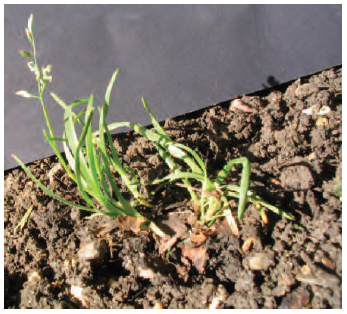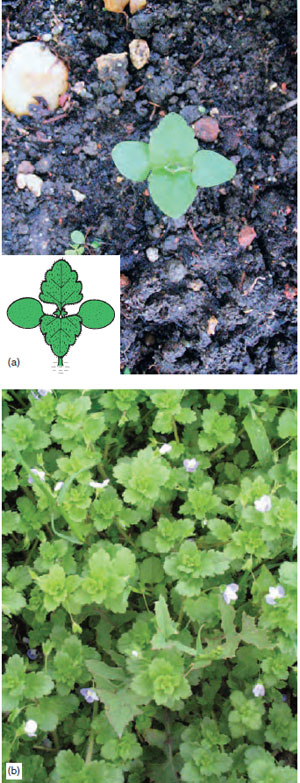Annual weeds
Content
While there are at least 50 successful annual weed species in horticulture, this book can cover only a few examples that illustrate the main points of life cycles and control. Two species, annual meadow grass and speedwell, are described. Annual meadow grass (Poa annua). Plant family – Poaceae (Graminae)
Life cycle: Flowers can occur at any time of year and are usually selfpollinated. About 2000 seeds per plant are produced from April to September. Plants will flower and seed even when mown regularly. Seeds germinate from February to November with the main peaks in early spring and autumn. Some seed will germinate soon after their release; others can remain viable in soil for at least 4 years. This weed species can be the host of a number of nematode species that also attack important crops. Spread: There is no obvious dispersal mechanism. Most seeds fall around the parent plant and become incorporated into the soil. Seeds may be carried around on boots and wheels of machinery. Worms may bring seeds to the soil surface in worm casts. Control is achieved by a variety of methods. The physical action of hoeing normally controls the weed especially when it is in the young stage. Deep digging-in of seedlings and young plants is also usually effective. Mulching is effective against germinating weeds in flower beds and fruit areas. The amateur gardener can use the non-selective, non-residual herbicide, glufosi-nate-ammonium plus fatty acids, for control in situations such as ornamental beds containing woody perennials and in cane fruit. The professional horticulturalist may use paraquat or glyphosate for total chemical control, but these two chemicals should never be sprayed in the vicinity of growing crops. Care should be taken not to walk on grass after application of these chemicals. Chlorpropham may be used as a soil applied chemical on crops such as currants, onions and chrysanthemum. Speedwells (Veronica persica and V. filiformis). Plant family – Scrophulariaceae
Life cycle: The seedling cotyledons are spade shaped, while the true leaves are opposite, notched and hairy (see Figure 13.9) in both species. The adult plants have erect, hairy stems and rather similar broadtoothed leaves. V. persica produces up to 300 bright blue flowers, 1 cm wide, per plant. The flowers are self-fertile and occur throughout the year, but mainly between February and November. The adult plant produces an average of 2000 light brown boatshaped seeds 2 mm across. The seeds of this species germinate below soil level all year round, but most commonly from March to May (see Figure 13.5), the winter period being necessary to break dormancy. Seeds may remain viable for more than 2 years. V. filiformis produces self-sterile purplish-blue flowers between March and May, and spreads by means of prostrate stems which root at their nodes to invade fine and coarse turf, especially in damp areas. Segments of this weed cut by lawnmowers easily root and further increase the species. Seeds are not important in its spread. Spread: Seeds of V. persica falling to the ground may be dispersed by ants. Seed of this species can be spread as contaminants of crop seed. V. filiformis does not produce seed. Its slow spread is mainly by means of grass-cutting machinery. Control: Field speedwell (V. persica) is controlled by a combination of methods. The physical action of hoeing or mechanical cultivation, particularly in spring, prevents developing seedlings from growing to mature plants and producing their many seeds. The amateur gardener can use the herbicide, glufosinate-ammonium plus fatty acids for control in situations such as ornamental beds containing woody perennials and in cane fruit. For the professional grower, total contact herbicides, such as paraquat, may be sprayed to control the weed on paths or in fallow soils. Soilacting chemicals such as chlorpropham on crops such as lettuce, onions and chrysanthemums kill off the germinating weed seedling. A contact, foliar chemical such as clopyralid, may be sprayed on to brassicas, young onions, and strawberries to control emerging seedlings. The slender speedwell (V. filiformis) represents a different problem for control. Physical controls such as regular close mowing and spiking of turf removes the high humidity necessary for this weed’s establishment and development. The amateur gardener has difficulty controlling this weed with the turf herbicides available. The amateur or professional grower can control the weed in a turf seedbed using a total, contact chemical such as glufosinate-ammonium plus fatty acids, a few weeks before sowing the turf seed. This ‘stale seed bed’ method leaves the turf to establish relatively undisturbed by weeds. Organic growers may remove stale seedbed weeds by hoeing. professional growers can use a selective contact chemical such as chlorthal dimethyl which is effective against this weed in established grass. |
||||||||||||||||||||||||||||






